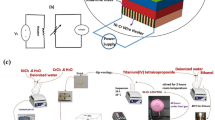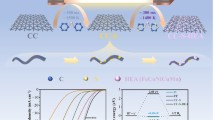Abstract
High quality Ti4O7 powder was synthesized by carbothermal reduction in flowing argon atmosphere and in vacuum. Phase evolution sequences during reaction and influence of main technological parameters such as compacting pressure, different heating temperature and reducing time and carbon black mole ratio in flowing argon atmosphere were investigated by X-ray diffraction and scanning electron microscope. Concluding the effect of main technological parameters, the carbothermal reaction was mainly controlled by solid phase-boundary reaction between the TiO2 and carbon black particles at the first stage. As the reduction progresses and the particle size increased, the contacting area between TiO2 and carbon particles decreased. The indirect reactions reduced by CO gas proceeding through gaseous intermediates subsequently accelerate the rate of the whole reaction at the second stage. The Rietveld (R) plot result showed that high quality of 98.5 % content Ti4O7 powders were obtained at 1100 °C in flowing argon atmosphere for 2.5 h and they were mainly in regular cylindrical morphology with an average diameter of 5 μm. The high quality of 87.5 % content Ti4O7 powders were obtained by reduced at 1025 °C in vacuum for 2 h and they were mainly in irregular spherical morphology with an average particle size of 2.10 μm. The resistance of the Ti4O7 powders and ceramics prepared by SPS showed that the good dispersed cylindrical Ti4O7 particles produced in argon atmosphere was good to fabricate Ti4O7 electrode.














Similar content being viewed by others
References
L. Zheng, The preparation and oxygen-sensing properties of α-Ti3O5 thin film. Sens. Actuators B Chem. 88(2), 115–119 (2003)
M. Canillas, E. Chinarro, M. Carballo-Vila et al., Physico-chemical properties of the Ti5O9 Magneli phase with potential application as a neural stimulation electrode. J. Mater. Chem. B 1(46), 6459–6468 (2013)
P. Lv, H. Sun, Y. Mu et al., Ti5O9 in TiO2 nanotube array activates the visible-light absorption properties significantly. Electrochim. Acta 146, 186–193 (2014)
R.C. West (ed.), CRC Handbook of Chemistry and Physics (CRC Press, Boca Raton, 1987), p. 122
R.F. Bartholomew, D.R. Frankl, Electrical properties of some titanium oxides. Phys. Rev. 187, 828 (1969)
P.C.S. Hayfield, Development of a New Material—Monolithic Ti 4 O 7 (Royal Society of Chemistry, Cambridge, 2002)
D. Bejan, J.D. Malcolm, L. Morrison, N.J. Bunce, Mechanistic investigation of the conductive ceramic Ebonex® as an anode material. Electrochim. Acta 54, 5548–5556 (2009)
T. Ioroi, Z. Siroma, N. Fujiwara, S. Yamazaki, K. Yasuda, Sub-stochiometric titanium oxide-supported platinum electro-catalyst for polymer electrolyte fuel cells. Electrochem. Commun. 7, 183–188 (2005)
K. Ellis, A. Hill, J. Hill, A. Loyns, T. Partington, The performance of Ebonex® electrodes in bipolar lead-acid batteries. J. Power Sources 136, 366–371 (2004)
A.C. Loyns, A. Hill, K.G. Ellis et al., Bipolar batteries based on Ebonex technology. J. Power Sources 144(2), 329–337 (2005)
A.C. Loyns, A. Hill, K.G. Ellis, T.J. Partington, J.M. Hill, Bipolar batteries based on Ebonex® technology. J. Power Sources 144, 329–337 (2005)
L. Xiaoxia, L.Z. Aaron, Q. Wei, W. Haijiang, H. Rob, Z. Lei, Z. Jiujun, Magneli phase Ti4O7 electrode for oxygen reduction reaction and its implication for zinc-air rechargeable batteries. Electrochim. Acta 55, 5891–5898 (2010)
E. Fredriksson, J.O. Carlsson, Chemical vapour deposition of TiO and Ti2O3 from TiCl4/H2/CO2 gas mixtures. Surf. Coat. Technol. 73(3), 160–169 (1995)
C. Tang, D. Zhou, Q. Zhang, Synthesis and characterization of Magneli phases: reduction of TiO2 in a decomposed NH3 atmosphere. Mater. Lett. 79, 42–44 (2012)
A.A. Gusev, E.G. Avvakumov, O.B. Vinokurova, Synthesis of Ti4O7 magneli phase using mechanical activation. Sci. Sinter. 35(3), 141–145 (2003)
R. Zhu, Y. Liu, J. Ye et al., Magnéli phase Ti4O7 powder from carbothermal reduction method: formation, conductivity and optical properties. J. Mater. Sci. Mater. Electron. 24(12), 4853–4856 (2013)
Y. Wang, F. Li, B. Yan et al., Kinetic study on preparation of substoichiometric titanium oxide via carbothermal process. J. Therm. Anal. Calorim. 122(2), 635–644 (2015)
E.T. Turkdogan, J.V. Vinters, Effect of carbon monoxide on the rate of oxidation of charcoal, graphite and coke in carbon dioxide. Carbon 8(1), 39–53 (1970)
L. Rongti, P. Wei, M. Sano, Kinetics and mechanism of carbothermic reduction of magnesia. Metall. Mater. Trans. B 34(4), 433–437 (2003)
B.V. L’vov, Mechanism of carbothermal reduction of iron, cobalt, nickel and copper oxides. Thermochim. Acta 360(2), 109–120 (2000)
Acknowledgments
This work was supported by Program for New Century Excellent Talents in University (NETC-13-0394) and the Panzhihua City Science Research Program of China (Nos. 2012CYG16 and 2015CY-G15).
Author information
Authors and Affiliations
Corresponding author
Rights and permissions
About this article
Cite this article
Li, X., Liu, Y. & Ye, J. Investigation of fabrication of Ti4O7 by carbothermal reduction in argon atmosphere and vacuum. J Mater Sci: Mater Electron 27, 3683–3692 (2016). https://doi.org/10.1007/s10854-015-4208-4
Received:
Accepted:
Published:
Issue Date:
DOI: https://doi.org/10.1007/s10854-015-4208-4




